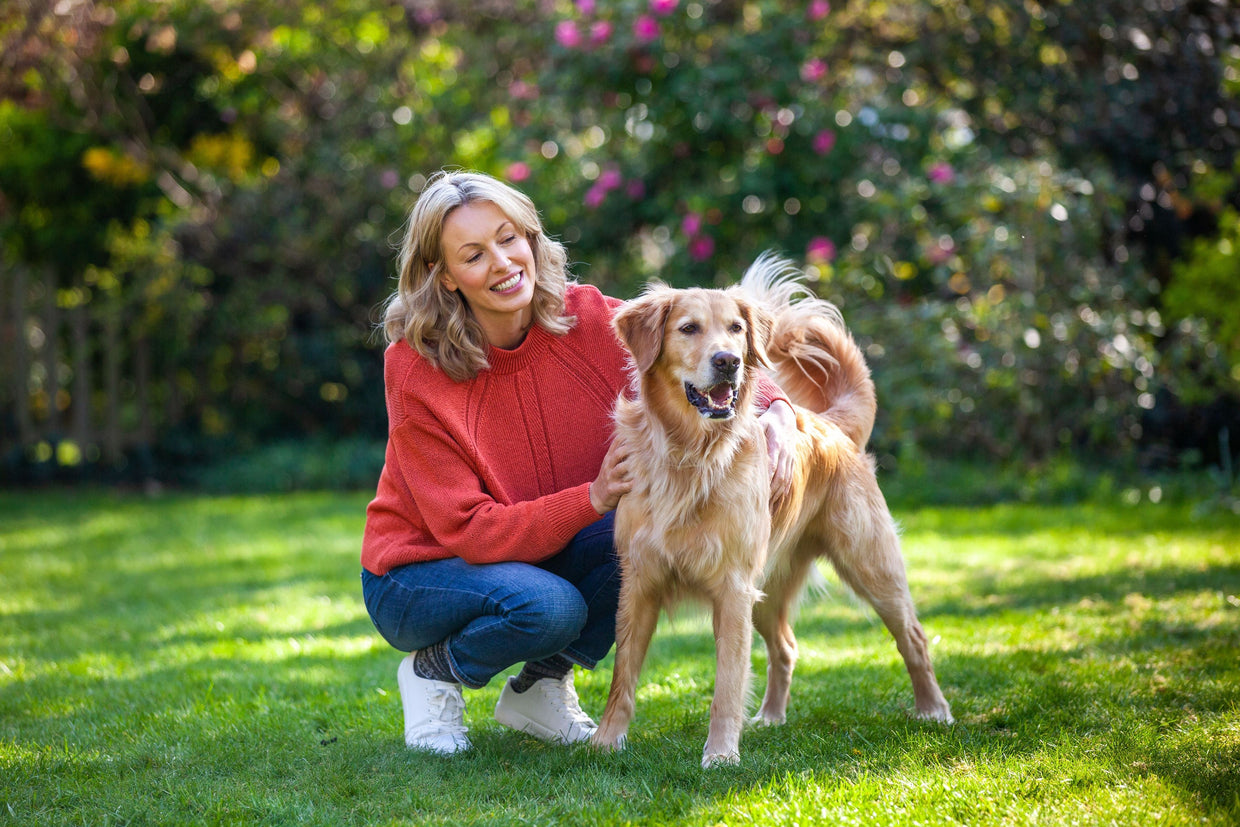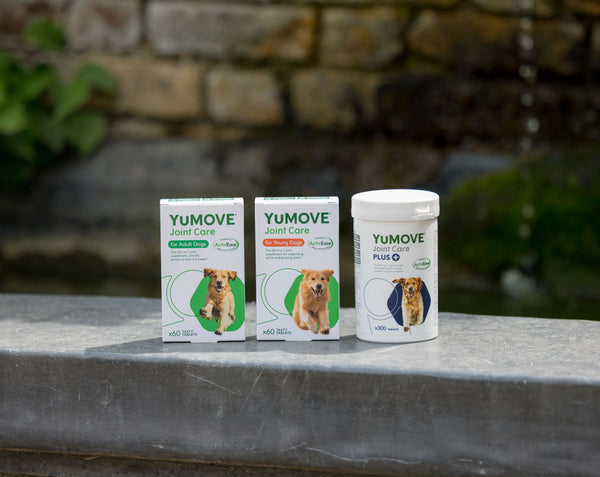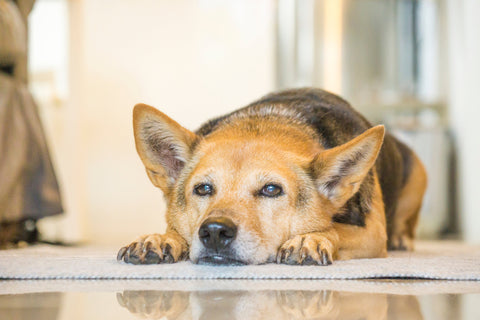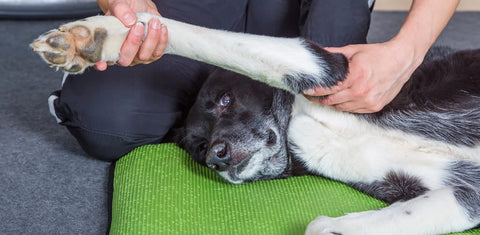

PAWS to spot mobility issues
To celebrate the first ever National Dog Mobility Awareness Week, we’re introducing PAWS, a brand new way to spot mobility issues, and we share tips from Battersea on helping dogs with stiff joints.
Improving your dog’s wellbeing
No one knows your dog like you do. You know when they want to play, when they want to go out for a walk, and you definitely know when they want you to make a fuss of them. But do you know how to spot the early signs of mobility issues?
At Lintbells, we’re always looking for new ways to help improve dogs’ happiness and wellbeing. That’s why we launched the first ever National Dog Mobility Awareness Week on 27th May.
Is your dog slowing down on walks?

Research has shown that more than 10 per cent of dog owners have noticed a change in their dog’s walking pace and nearly 9 per cent say their dogs run less than before.*
Due to lack of awareness these signs are often assumed to be part of the ageing process and just general ‘slowing down’.
However, if your dog is hanging back on walks or is less keen to chase after a ball than usual, it might not simply be because they’re getting on a bit. It could be that your pooch has mobility issues.
Spot mobility issues with our new PAWS system
Especially for National Dog Mobility Awareness Week, we’ve created a new ‘PAWS’ system to help dog owners spot potential signs of trouble. Drawing on the advice of qualified vets and pet experts, it highlights key signs that could indicate that your dog is experiencing mobility issues.

Posture – Have you seen any changes in your dog’s body shape, muscle strength or simply in the way they walk?
Attitude – Has your dog unexpectedly changed the way they react to you, your family or to other dogs?
Willingness – Is your dog still up for walks, for games, for bouncing in and out of the car and barking at every little thing?
Slowing down – Has your dog been slowing down lately – sooner than you hoped they might?
If you think your dog is showing any of these signs, we recommend getting advice from your vet, checking that your dog is the right weight, giving your dog appropriate exercise and seeing if you can make your home more suitable for your pet.
![]()
Battersea: looking after over 7,000 animals a year
Each year, Battersea cares for over 7,000 animals, helping every dog and cat that arrives at their gates and beyond. This means that the charity treats animals with a range of physical conditions, including mobility issues.
Every dog and cat that comes in to Battersea receives a full health check from the expert veterinary team on arrival. They watch how the animals move and look for any issues that might have an impact on an animal’s mobility, as well as making sure every animal is neutered and microchipped before they leave. A unique care plan is created during their stay with the rescue centre, making sure that animals are assessed and supported and are behaviourally and medically fit to go to their forever homes.
Proud to partner with Battersea
Lintbells is proud to partner with Battersea to help every dog and cat live an active, happy life in their new home, which is why we asked them for their tips on how to look after animals with mobility issues.
Robert Young, Head of Operations at Battersea, said: “Mobility plays a very important part in promoting positive wellbeing. Anything that impacts on an animal’s mobility could prevent dogs or cats getting the exercise they need to keep them happy and healthy, potentially leading to other issues that may affect your pet’s wellbeing.”
Mobility tips from Battersea
Discover how to help a dog with mobility issues by adapting their exercise routine and making a few simple changes to your home environment.
Tailor exercise to your individual dog’s needs
The type of exercise your pet needs depends on the individual animal. Battersea recommends that you consult with your local vet to ensure exercise is tailored specifically for your dog.
As standard, Battersea would advise taking your dog out for a walk at least twice a day – but it really is dependent on the breed, age and condition of your dog. It’s more about the quality of the exercise and assessing if your dog will enjoy it.
How much exercise does your dog need?
Try the YuMOVE exercise calculator to see how much exercise different breeds need, on average.

Older dogs might prefer a potter or being with their owner
Some dogs may prefer a gentle stroll, younger dogs may enjoy a chase around the park, but we also know some older dogs will happily potter around in the garden.
Older dogs are often much more relaxed than younger dogs, and in a lot of cases they’d rather just go for a toilet break outside then have a cuddle on the sofa and some human affection.
As long as your pet isn’t struggling at any point then they will be happy just spending quality time with their owner.
Take care with strenuous play for older dogs
If your older dog is showing a strong willingness to chase tennis balls and play, you should take care to reduce that time to avoid any injuries or further inflammation of joints.

Consider alternatives to walks
If walking is a struggle, consider alternative ways to keep your pet busy such as fun puzzle feeders or stimulating toys to play with.
Make life easy at home
If your dog looks like it has stiff joints, Battersea advises making life as easy as possible for your pet and avoiding anything that might make the condition worse. For example, this might mean avoiding the need for your dog to go up and down stairs if possible, minimising any big jumps up or leaps down they need to make and providing easy access to food and beds. For instance, raised food bowls can help minimise the amount that your dog needs to stretch.
PAWS for thought
For over a decade Lintbells has supported animal mobility through YuMOVE, a range of natural joint supplements packed full of unique ingredients that help dogs that are experiencing mobility issues.

With National Dog Mobility Awareness Week, we want to help pet owners understand the signs of joint stiffness and loss of mobility to ensure they can take action before these issues affect their pets’ physical and emotional wellbeing.
* Lintbells 2019 survey






